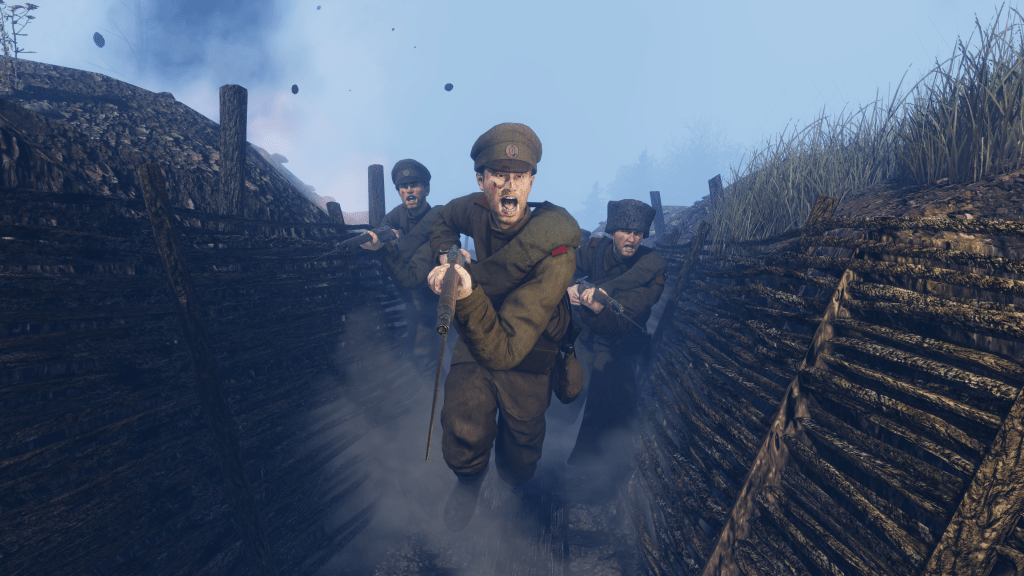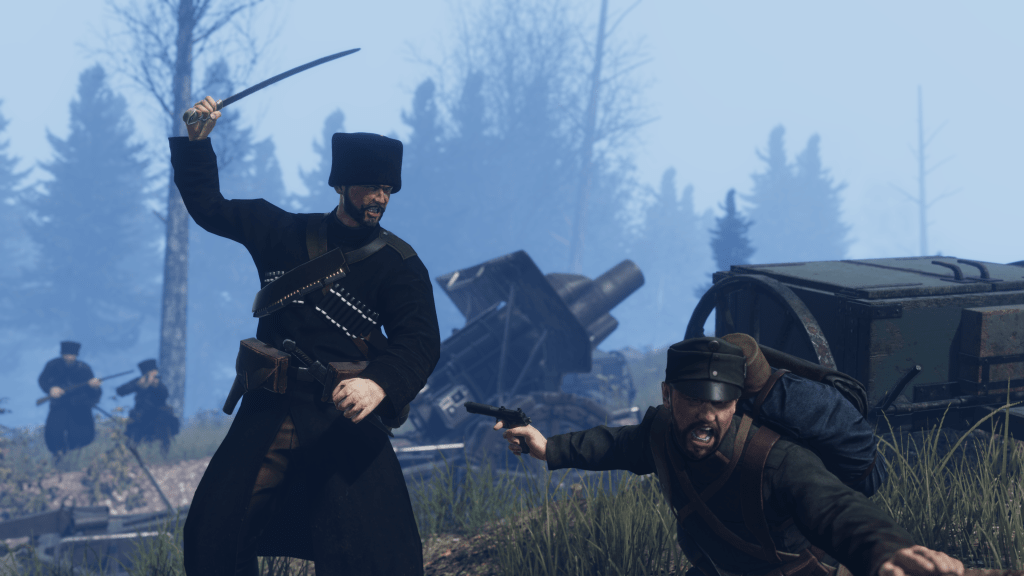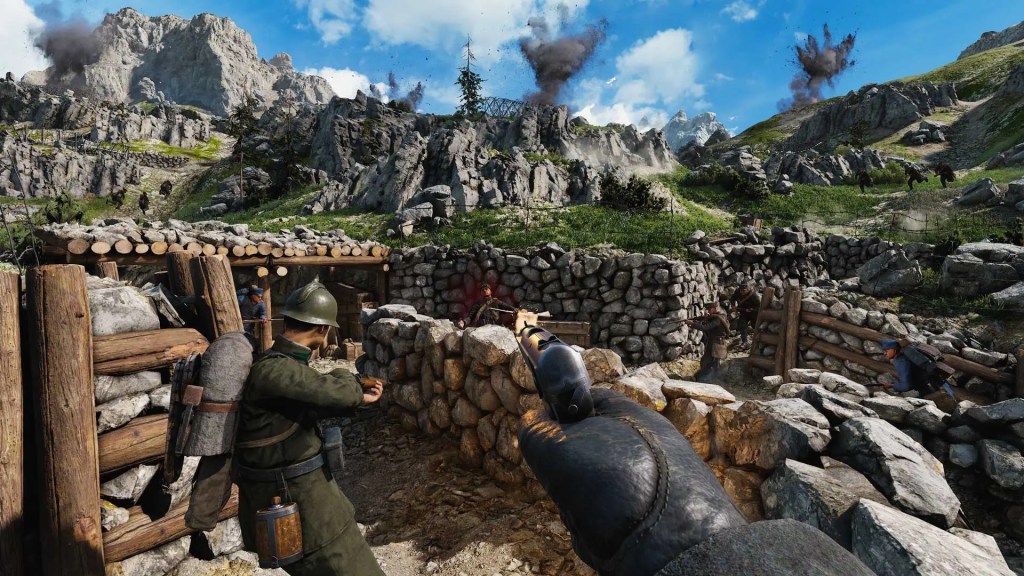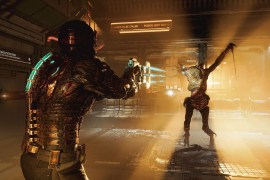Building a war zone: how Jos Hoebe created Isonzo
With the WW1 series, Hoebe's depiction of war is one of the most realistic in gaming. How did he do it?

What makes a war zone? In the video game world, it can be pretty much anything. Medal of Honor puts us in frantic, sometimes futuristic terrain with enough weaponry to arm a nation. Wolfenstein portrays a dystopian, alternate history. In Destiny 2, war has broken out beyond our own world to alien planets. But how do you build a war zone? Jos Hoebe, co-Founder of Blackmill Games, knows.
Hoebe and his team are behind the WW1 game series, a multiplayer shooter set across the battlefields of Europe and Russia in the First World War. The trio of current games began with Verdun, which took place on the Western Front between 1914 and 1918. In Tannenberg, you have to withstand artillery barrages and poison gas while battling through the Eastern Front. The latest title, Isonzo, takes you to the Italian frontlines. You must fight across mountainous landscapes and wade through the trenches in what is one of the most realistic, true to life war games out there.
Here, we talk with Hoebe about how he builds a war, why ‘realism’ is hard to define and the importance of shedding light on history through gaming.
How did you get started on what would eventually become the game?
It goes way back. When I was little. I visited the trenches near Verdun. I was there when I was 12. In the forest there, there are still trenches. You can still see the remnants of war. You can see grenades on the ground in a random forest. You can still find relics. As a 12 year old, it was fascinating.
Ever since then, I wanted to do something creative with World War I as a team. I was making modifications for the old Medal of Honor in the early 2000s. That hobby turned into a job, which has been running since 2006. We launched in 2013 on Steam, and it took off from there.
Was there something you felt was missing from typical war shooters, particularly those set in World War I and II?

Battlefield 1 came out in 2016, but when we were making our game before that, nobody had made a World War I shooter. It was always World War II and Normandy, never the trenches of Verdun. We took something unique and made it into a game. That’s how we originated. We wanted build a game around World War I, rather than take a shooter and pour World War I sauce over it.
Did you always want it to have the level of realism that it did? Or did that develop over time through your experiences?
One thing follows the other. If you make a realistic level, you don’t have jetpacks in them. That’s an extreme example, but you get the idea.
When we started, the fanbase and the community expected something realistic. That automatically steered the game into the realistic angle. Realism, though, means something different to every person you ask. It’s a subjective term, but you can break it down into into several subcomponents.
There’s physical realism – how fast you aim your rifle, or walk around the terrain. There’s authenticity – are you in the right battle, with the right weapon and the right uniform? You can play with both parameters. Sometimes they overlap. The respawn times are really fast in our game, and that’s unrealistic but it doesn’t mess with the authenticity of the of the situation you’re fighting it. Same goes for how you you operate your rifle. It doesn’t jam all the time, which may have happened, but it wouldn’t be fun. It’s a balancing act.
How do you begin to build a war zone? What are the components of that?
One of our core pillars is to be as representative as possible of what happens. You can cherry pick what you want, but we try to build levels in where the fighting actually took place. It’s very cool to make all these Alpine levels, but in the end, most of the soldiers fought near the sea. That’s where we choose to put our initial focus. That’s where most of the fighting took place for hundreds and thousands of soldiers, rather than a mountain peak where maybe a few hundred of dozens of people fought. That’s not representative of the fighting and combat as a whole.
Then, we look at the style of fighting. The Western Front was a meat grinder, back and forth. One would attack, then a similar counter attack. There were waves of humans fighting over the same plot of land and not advancing much. In the Eastern front, there was more room to manoeuvre. There was vast expanses of forest, but it still had trench warfare. All battlefields have their unique angles to approaching the same subject.
Were you going to these places to scout them out in the development process?
Not every single place, but you have to get the idea of the environment you’re representing.
When you visit, you really get the sense of scale and the important elements when you’re physically there. And in the game, people recognise these places. They recognise the train station and the streets, because you’re recreating something from real life. The proportions of the landmarks are what they are in real life. You can even recognise the shape of the hills in the game.
When it came to the weapons, uniforms and the style of fighting, what were some of the ways you achieved that in the game?
It’s a combination of things. We have written material, and there’s lots of online material. Records, diaries, the maps are findable. For weapons, there’s lots of YouTube channels that detail and explain where every screw goes, why and how it works.
For the uniforms, we talked to war reenactors. They know lots about very, very specific things about the uniform – where every button goes on the uniform, for example. It’s very niche. It’s not like you can go to a history professor and ask about Austro-Hungarian uniforms in 1915. It’s not something that’s in books, per se. So finding people with specific knowledge who are passionate about that subject is important.
Have you become a bit of a historian in the process?

We’re certainly not done with Isonzo. There’s many more battles and weapons to add to tell the whole story as much as possible. If you try to make a game about the whole war, you have to cherrypick. If WWI is a theme, you can try to do too much, so we try to zoom into very specific battles.
Nobody is going to recreate the Battle of Sabatino. Others may try to pick the ‘coolest’ battles, but we can go deeper into the detail and tell a more complex story. And that’s appreciated by people. They see levels and environments they’ve never seen before, and will likely never see again. I don’t think anyone will make an Italian front WWI shooter anytime soon.
How do you balance creating a battlefield that tells those real stories, with something that’s enjoyable for players?
It’s always a balancing act. When you pick a location, the representation is important. Are you telling the story that the average soldier would have lived through? The bulk of the troops in the Italian front were deployed in the south, which is a bit boring because it’s a flat area. So you have to make a choice, are you gonna go for the cool locations? Or the one that’s accurate?
But because we are so specific we can do both. We made the south as the as the biggest stage in the game with multiple levels there, but we can then include some of the less representative but cooler locations. In Isonzo, we have a stage set in the Dolomites mountains. That’s really dramatic, but in reality there were only a handful of troops deployed there. There are several levels which are in the less interesting locations for gaming, but within that you try to pick the unique attributes that location offers.
When I’ve been playing WW1, you get that feeling of franticness and bewildering gameplay, which makes for a very real playing environment.
We also try to pick a balance between realism, as in scale. Our games are pretty condensed and very fast paced. You always spawn within 100 metres of your enemy. You’re directly in the action, sometimes even too close. The average life expectancy in the game is around 30 seconds.
You die a lot, but we’re representing battles where hundreds of thousands of troops were involved, and you have to condense it into a format for 50 players in a multiplayer match. You have to create the feeling of going over the top together as a team and charge the barbed wire. We try to put the player in situations which are similar to what a single soldier would have experienced in a large battle.
Was it difficult to bridge that gap between creating something that is rooted in real events, and then making something that was fun to play?
That is tough. It’s a matter of taking the right compromises here and there to make it work. Other titles design their levels with accuracy, but dump in experimental weapons and basically go all out on the fantasy stuff. We do not.
Maybe you can unlock something that’s slightly experimental, but that’s very rare. A double barreled machine gun for instance, or old rifles from the 1800s. We can still realistically claim that those things would have been there at the battle. We want to stay within believability.
Some war games are so absurd, they kind of become offensive when you remember they’re rooted in fact. Is that something you thought about? And does time allow you to make games from war?

Yeah. At some point, it’s crossing a line. But there’s a slider. There are no jetpacks or people with crazy speed, but you don’t want to be so realistic that you have to catch your breath every time you shoot. It’s always trying to find the middle ground.
For us, we’re two generations away from World War I, and there was no obvious evil protagonist. With that, what we can do is very verbatim. We can show the battles and the units without offending that much. But for conflicts that are actively going on? I wouldn’t touch it.
Finally, for you, why is there still a desire to tell these stories in this way?
It’s important to shed light to under represented themes in history. We can introduce very specific battles to people who’ve never heard of it, instead of rehashing the same thing over and over again. People can be educated through that, too. There’s an archival aspect to it. We recreated a landscape on the border between Italy and Slovenia that doesn’t exist anymore.
We were able to recreate that through archival footage. Back then, it looked like a stone hellscape with no foliage. Now, it’s a forest. We’re transporting players back to something that is no longer there. In a thousand years, people will see this in the game. That’s a high level goal, but it’s a motivator.


